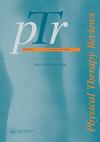当在沉浸式虚拟现实环境中评估时,慢性非特异性颈部疼痛患者的运动学和感觉运动控制与健康个体不同吗?系统回顾
IF 0.8
Q4 REHABILITATION
引用次数: 0
摘要
摘要目的比较在沉浸式虚拟现实(VR)环境中评估的慢性非特异性颈部疼痛(CNSNP)患者与健康对照组的颈部运动学和感觉运动控制(即参与维持关节稳定性的所有传入、传出、中枢整合和处理组分)。方法在四个数据库中进行全面的电子搜索,以确定从创办到2022年6月发表的文章。搜索词与“颈部疼痛”和“虚拟现实”有关。纳入标准是用英语或法语撰写的观察性研究,包括大多数CNSNP患者(≥60%),并在沉浸式VR环境中比较CNSNP人群和健康对照者的颈部运动学或感觉运动控制。方法学质量使用乔安娜·布里格斯研究所横断面研究关键评估清单进行评估。使用GRADE方法评估证据的总体确定性。结果共纳入7项研究。每项研究都提供了与评估结果相关的结果摘要。方法学质量从中等到良好。与健康对照组相比,CNSNP患者的颈部运动学似乎发生了变化,除了运动范围和反应时间。感觉运动控制评估结果不一致。运动学和感觉运动控制的证据确定性都很低。结论当在沉浸式VR环境中进行评估时,这项系统综述提供了非常低的证据确定性,有利于健康个体和CNSNP患者之间不同的运动颈部模式。关于感觉运动控制还不能得出结论。本文章由计算机程序翻译,如有差异,请以英文原文为准。
Do the kinematics and sensorimotor control of people with chronic non-specific neck pain differ from those of healthy individuals when assessed in an immersive virtual reality environment? A systematic review
Abstract Objective To compare the cervical kinematics and sensorimotor control (i.e., all the afferent, efferent, central integration, and processing components involved in maintaining joint stability) of people with chronic non-specific neck pain (CNSNP) to healthy controls, as assessed in an immersive virtual reality (VR) environment. Methods A comprehensive electronic search was conducted in four databases to identify articles published from inception up until June 2022. The search terms were related to ‘neck pain’ and ‘virtual reality’. Inclusion criteria were observational studies, written in English or French, including a majority of people with CNSNP (≥ 60%), and comparing the cervical kinematics or sensorimotor control between people with CNSNP and healthy controls in an immersive VR environment. Methodological quality was assessed using the Joanna Briggs Institute Critical Appraisal Checklist for Cross-Sectional Studies. The overall certainty of evidence was assessed using the GRADE approach. Results Seven studies were included in the review. A narrative summary of results is provided for each study in relation to the outcomes assessed. Methodological quality was moderate to good. Cervical kinematics seemed to be altered in people with CNSNP compared with healthy controls, except for range of motion and response time. Sensorimotor control assessment showed inconsistent results. The certainty of evidence was very low for both kinematics and sensorimotor control. Conclusion This systematic review provides very low certainty of evidence in favor of different kinematic neck patterns between healthy individuals and people with CNSNP when assessed in an immersive VR environment. No conclusion can be drawn concerning sensorimotor control.
求助全文
通过发布文献求助,成功后即可免费获取论文全文。
去求助
来源期刊

Physical Therapy Reviews
REHABILITATION-
CiteScore
1.30
自引率
0.00%
发文量
26
期刊介绍:
Physical Therapy Reviews is an international journal which aims to publish contemporary reviews, discussion papers and editorials within physical therapy, and in those basic and clinical sciences which are the basis of physical therapy. The journal is aimed at all those involved in research, teaching and practice within the area of physical therapy. Reviews (both descriptive and systematic) are invited in the following areas, which reflect the breadth and diversity of practice within physical therapy: •neurological rehabilitation •movement and exercise •orthopaedics and rheumatology •manual therapy and massage •sports medicine •measurement •chest physiotherapy •electrotherapeutics •obstetrics and gynaecology •complementary therapies •professional issues •musculoskeletal rehabilitation
 求助内容:
求助内容: 应助结果提醒方式:
应助结果提醒方式:


